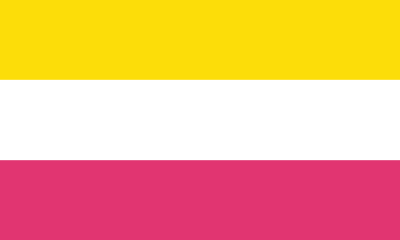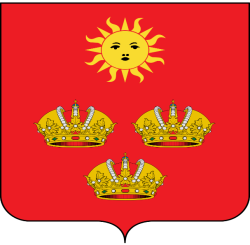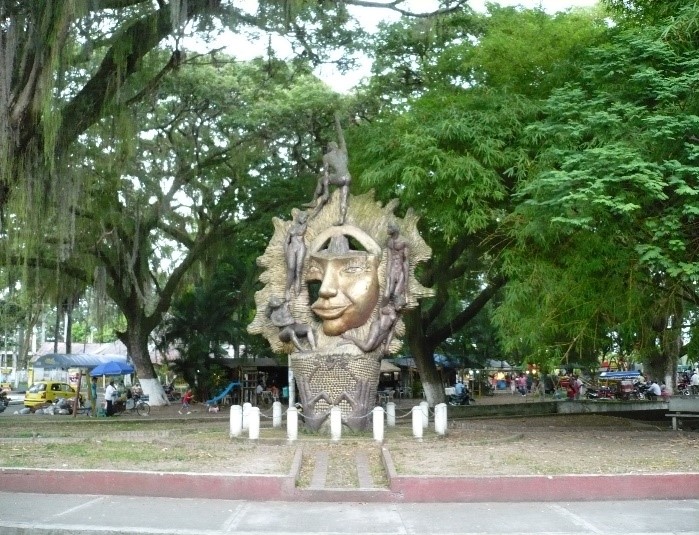Cartago
Department
Valle del Cauca, Colombia

Flag of the city
The flag of Cartago, adorned with bands of yellow, white, and pink, stands as a testament to the city’s rich heritage. Each colour on the flag carries a deeper meaning. Yellow, commonly found on many flags, signifies wealth and prosperity, often alluding to a region’s resources or its sunny disposition. The white band epitomizes peace, unity, and purity, ideals that many municipalities strive for. Lastly, the pink could point to Cartago’s unique cultural or historical nuances.

Seal of the city
The shield of Cartago is designed in a traditional Spanish style with rounded edges at the bottom, culminating in a protruding point. The backdrop, colored in gules (red), features a golden sun at the centre top, which is uniquely detailed with eyes, nose, and mouth. This sun is illuminated with 16 rays, alternating between 8 straight and 8 flaming, and all radiating from the central straight ray. Completing the design are three imperial crowns: two aligned horizontally and the third strategically placed at the shield’s bottom point.

Slogan of the city
Cartago, Valle del Cauca, Colombia is often referred to as the “City of the Bamboo” or “Ciudad Bambuquera” in Spanish, due to its extensive bamboo forests and its traditional use of bamboo in construction and craftwork.
History

Founded in 1563, Cartago once held the title of Costa Rica’s capital until 1823. Its history is marked by natural disasters; earthquakes and volcanic eruptions have frequently reshaped the city. The devastating 1910 earthquake stands out, as do the 1963-65 eruptions from the Irazú Volcano, which caused significant flood and mudslide damage.
A prominent religious site, the Basilica of Our Lady of the Angels, houses a revered black Madonna, attracting many pilgrims. Another attraction is the Lankester Botanical Gardens, which showcases a vast collection of exotic orchids and operates as a research center under the University of Costa Rica. The city is also home to the Technological Institute of Cartago, established in 1971, renowned for its contributions to science and technology. A highlight for both locals and tourists is Cartago’s Sunday market. The city’s connectivity to the national capital, San José, is facilitated by the Inter-American Highway and the Costa Rica Railway.
Geography of the city
Cartago, positioned at coordinates 4°44′N 75°55′W, is a city nestled in the northern part of the Valle del Cauca department in Colombia. Elevated at approximately 917 meters (3,009 ft) above sea level, it lies in the scenic Cauca River valley. The city’s tropical savanna climate is attributed to its altitude, making it warmer and drier than southern cities in the department, like Cali. Moreover, Cartago’s strategic location places it in close proximity to the Coffee Triangle or “Eje Cafetero”. Specifically, it is near cities such as Pereira and Armenia, with Pereira being around 34 km away and Armenia approximately 55 km away. This positioning and its unique geography make Cartago a significant city in the region.

Population
137 901 (2023) projection
134,972 (2019)
One photo representative of the city
One of the most famous places in Cartago, Valle del Cauca, Colombia, is the “Parque de la Isleta”. This park, located in the heart of the city, is a popular gathering spot for locals and tourists alike. It’s characterized by its beautiful landscapes, fountains, and sculptures. Additionally, it’s surrounded by historic buildings and churches, making it a focal point for those interested in the city’s architecture and history. The park often hosts various cultural events and activities, adding to its significance in the daily life of Cartago’s residents.

Etymology
The name “Cartago” for the city in Valle del Cauca, Colombia, traces its origins back to the ancient city of Carthage in modern-day Tunisia. The original Carthage was a significant Phoenician city-state and later a major power in the Mediterranean before its eventual destruction by Rome. The naming of the Colombian city as “Cartago” is reflective of a common practice during the colonial era, where Spanish settlers would name new settlements after places from classical antiquity or other parts of the world. In this context, “Cartago” in Colombia serves as a testament to the influence and memory of ancient Carthage.
What the city is known or famous for
Cartago stands out prominently on the Colombian map for its rich tradition of handicrafts, with a special emphasis on embroidery. This age-old art form has been passed down through generations, transforming it into a cultural heritage of the city. The intricate embroidery patterns, characterized by their detailed craftsmanship and unique designs, reflect the soul and essence of Cartago’s traditions. The artisans of the city take immense pride in their work, creating pieces that range from clothing and accessories to home décor items. The meticulous attention to detail and the unparalleled precision in each stitch have elevated Cartago’s embroidery to be ranked among the finest in Colombia. This artistic endeavor not only contributes to the city’s cultural identity but also plays a significant role in its economy, attracting tourists and enthusiasts from various parts of the country and beyond. With numerous local workshops and markets dedicated to showcasing these handicrafts, Cartago stands as a beacon for preserving and celebrating the art of embroidery in modern times.

